Motorola Droid Bionic - A Quick Preview
by Brian Klug on September 12, 2011 4:35 AM EST- Posted in
- Smartphones
- Droid
- LTE
- Motorola
- Android
- Mobile
- motorola droid bionic
Motorola Droid Bionic Preview
Hot off the heels of finishing our Samsung Galaxy S 2 review, I'm off to Microsoft's BUILD conference with Ryan while Anand covers IDF. Before we get knee deep in all of that conference excitement however, I wanted to give a quick preview of the Motorola Droid Bionic which I've had for close to a week now.
For Verizon subscribers, the Bionic has easily been the most anticipated device of the summer, as it's the first 4G LTE enabled smartphone with a dual core SoC. If you haven't been keeping track, up until now, 4G LTE basebands and dual core SoCs have been mutually exclusive in smartphones. The result is that in many cases page load speed and overall snappiness has been gated by single core SoCs.
| Physical Comparison | ||||||
| HTC Thunderbolt | Motorola Droid X2 | Motorola Droid 3 | Motorola Droid Bionic | |||
| Height | 122 mm (4.8") | 126.5 mm (4.98") | 123.3 mm (4.85") | 127.5 mm (5.02") | ||
| Width | 67 mm (2.63") | 65.5 mm (2.58") | 64.1 mm (2.52") | 66.9 mm (2.63") | ||
| Depth | 13.2 mm (0.52") | 9.9 - 14.4 mm (0.39"-0.57") | 12.9 mm (0.51") | 10.99 mm (0.43") | ||
| Weight | 183.3 g (6.46 oz) | 148.8 g (5.25 oz) | 184 g (6.49 oz) | 158 g (5.57 oz) | ||
| CPU | 1 GHz MSM8655 45nm Snapdragon | 1 GHz Dual Core Cortex-A9 Tegra 2 AP20H | 1 GHz Dual Core Cortex-A9 OMAP 4430 | 1 GHz Dual Core Cortex-A9 OMAP 4430 | ||
| GPU | Adreno 205 | ULP GeForce | PowerVR SGX 540 | PowerVR SGX 540 | ||
| RAM | 768 MB LPDDR2 | 512 MB LPDDR2 | 512 MB LPDDR2 | 1 GB LPDDR2 | ||
| NAND | 4 GB NAND with 32 GB microSD Class 4 preinstalled | 8 GB NAND, 8 GB microSD class 4 preinstalled | 16 GB NAND, up to 32 GB microSD | 16 GB NAND, 16 GB microSD class 4 preinstalled | ||
| Camera | 8 MP with autofocus and dual LED flash, 720p30 video recording, 1.3 MP front facing | 8 MP with AF/LED Flash, 720p30 video recording | 8 MP with AF/LED Flash, 1080p30 video recording, VGA (0.3MP) front facing | 8 MP with AF/LED Flash, 1080p30 video recording, VGA front facing | ||
| Screen | 4.3” 800 x 480 LCD-TFT | 4.3" 960 x 540 RGBW LCD | 4.0" 960 x 540 RGBW LCD | 4.3" 960 x 540 RGBW LCD | ||
| Battery | Removable 5.18 Whr | Removable 5.65 Whr | Removable 5.65 Whr | Removable 6.11 Whr | ||
I've had a chance to run a bunch of our benchmarks and a limited set of our battery life test suite on the Bionic before hopping on the plane, and wanted to share those numbers. Before we do that, let's take a look at the device aesthetics.
Physical Appearance
To start, the Bionic as it is now is nothing like the Bionic we were originally shown at CES. That's because the current Bionic is really a Targa, but that's besides the point.
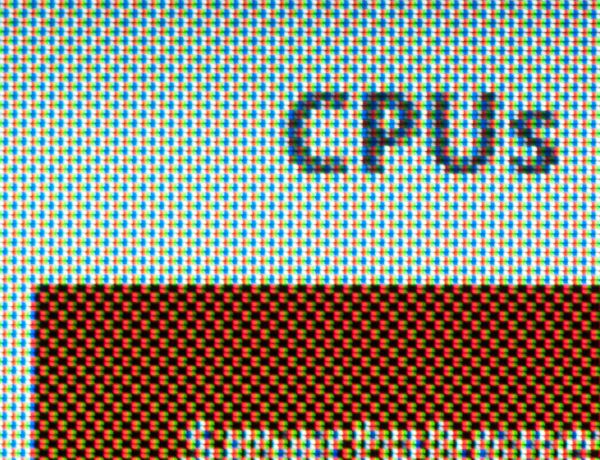
RGBW LCD on the Droid Bionic - 1:1 Macro
On the front of the device is a 4.3" qHD (960x540) RGBW-LCD display, which is effectively exactly the same as the display on the Droid X2 we took a look at earlier this summer.
I've gone ahead and measured display luminance as a function of brightness percentage, and found that the Bionic's display unsurprisingly follows the performance of the X2 identically - no doubt this is literally the exact same panel.
The display is lipped and tapers down into the plastic to a point just before it meets up with the bezel. Unfortunately, this seems to be a place that dust and lint are already congregating, especially at the bottom. I've already hit the Bionic with a blast of compressed air or two.
The capacitive buttons at the bottom retain the same Motorola style, backlighting, and order as we've seen before. Up at the top is a VGA front facing camera, and on the other side of the earpiece, the Bionic also includes a notification LED, something which will no doubt make many happy.
The rest of the Bionic honestly feels very closely related to the Droid X2. There's a microUSB and microHDMI port on the bottom left, located for use with the optional laptop dock.
On the other side is the volume rocker, and up at the very top is the headset jack and power button.
Probably my only major physical complaint about the Bionic is that the power button doesn't protrude enough, isn't clicky, and wobbles around quite a bit. It isn't communicatively clicky enough.
There's a notch on this back side for getting a thumb into, and peeling the back of the device off. The backside is a soft-touch brown material atop plastic.
Battery
Underneath that plastic battery cover is the device's relatively-large 6.6 Whr battery, which is marked as having a nominal voltage of 3.8 V and 1735 mAh capacity. The 3.8 V marking is a bit curious to me, as lithium-ion polymer batteries usually have a nominal voltage of 3.7 V. I haven't compared battery voltage at 0%, 50%, and 100% yet, but this seems curious to me. The battery is very thin, no doubt Motorola was concerned about not making the Bionic too thick. This also makes the Bionic's battery the largest inside any of the Verizon LTE smartphones.
| LTE Smartphone Battery Size Comparison | ||||||
| HTC Thunderbolt | LG Revolution | Samsung Droid Charge | Motorola Droid Bionic | |||
| Nominal Voltage | 3.7 V | 3.7 V | 3.7 V | 3.8 V | ||
| Capacity in Whr | Removable 5.18 Whr | Removable 5.6 Whr | Removable 5.92 Whr | Removable 6.6 Whr | ||
Of course on the back of the Bionic is the 8 MP rear facing camera with LED flash, speakerphone port at the bottom (the grille next to the camera doesn't seem to serve any purpose), and two microphones.
The overall appearance of the Bionic really is clearly inspired from the industrial design of the X2. The two phones share a thicker-at-top shape, the same 4.3" display, though the Bionic is just over 1 mm thicker at its thinnest point.
OMAP4430 + LTE
I've described the Bionic to multiple people as a Droid 3 with an X2 form factor and LTE, and that's really what it is at the end of the day. The Bionic uses the same OMAP 4430 SoC and Qualcomm MDM6600 for CDMA 1x and EVDO, though the Bionic has 1 GB of RAM. What's really different is that the Bionic is sans keyboard, and includes a Motorola-branded LTE baseband that we don't know much about at this point.
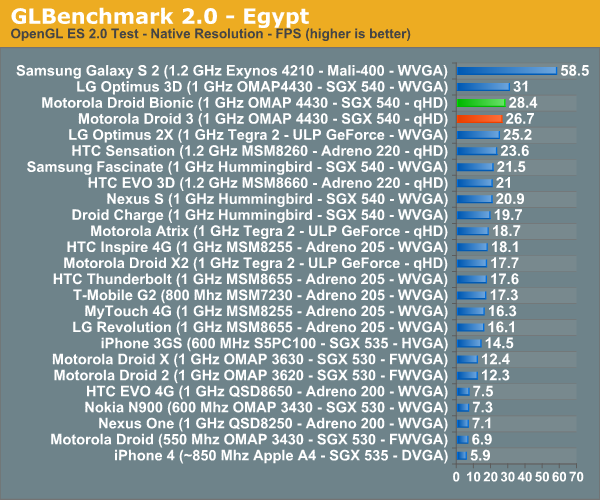

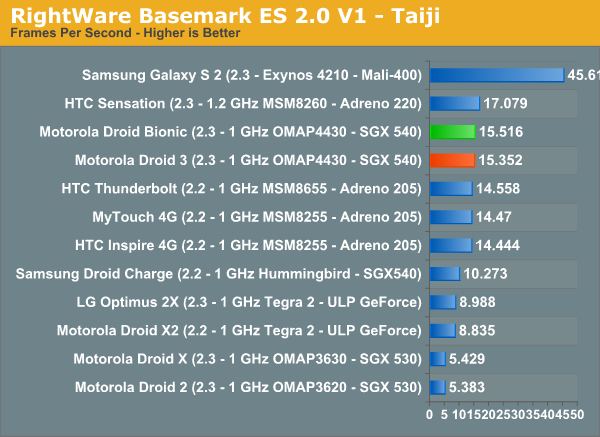
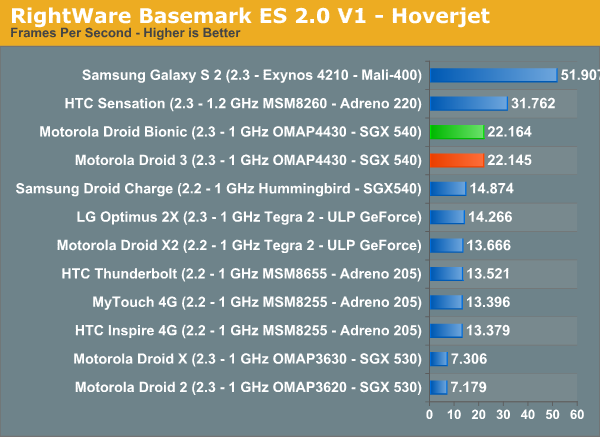
OMAP 4430 performance is something we've largely already gone over in the Droid 3 review, though I've again run all the benchmarks on the Bionic that we'd normally run. All that's really different here is an extra 512 MB of LPDDR2.
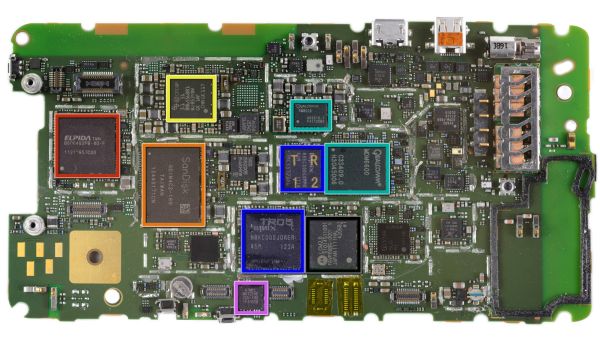
Motorola LTE LCM2.0 Baseband - Ensquared in Black Above, Courtesy iFixit
We first caught glimpse of the Bionic's mysterious LTE baseband inside the FCC photos, now courtesy of iFixit we have a better photo of the die and some markings. Unfortunately that's about all we know for certain, though it's highly likely the baseband is a LTE Category 3 device.
Throughput on LTE is where it should be with the Bionic. I've run over 400 speed tests in my freshly-enabled LTE market in Tucson, AZ, and a few in Phoenix, AZ. Average downstream is almost exactly 15.5 Mbps, with a standard deviation of 6.5 Mbps. I've seen a maximum of 39.1 Mbps so far.
Upstream is on average 5 Mbps with a standard deviation of 2 Mbps, and a maximum of 12.7 Mbps.
Latency is interesting, when I posted some early histograms, a number of people pointed out that latency is lower on the Bionic. Sure enough, I measured an average latency of 78ms on the Bionic, and 97ms when I tested the Thunderbolt a few months ago.
So throughput is where it should be, and 4G LTE connectivity on the Bionic doesn't seem to suffer from any dramatic issues other than a rare disconnect or two.
Battery Life
There's a big but coming, and that "but" is battery life. I haven't had a chance to run all the battery life tests yet, but I've run what I think are the two most important ones for the Bionic: smartphone web browsing on LTE, and WiFi hotspot on LTE. Bear in mind again that the Bionic has the largest battery of the four Verizon smartphones right now. I've also measured a charge from 0-100% time (with the display off and no use) of about 3 hours.
First up is the smartphone web browsing test, which consists of the device loading through a few dozen webpages with the display at 200 nits until the phone dies.
I think results speak for themselves. I actually had a chance to run this twice, which I did, just to ensure that the first test wasn't an errata. The second time the phone performed almost exactly the same, and I averaged the results together.
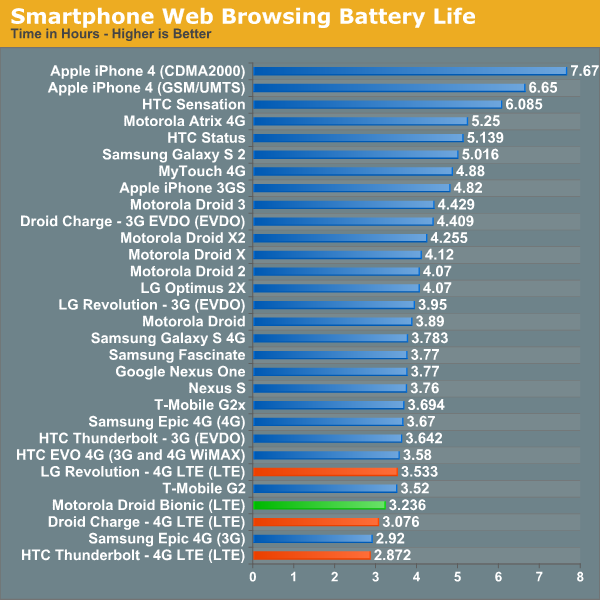
Next up is the WiFi hotspot test, where a notebook connected over WiFi to the device loads four tabs of the page load test alongside a 128 Kbps MP3 internet radio station, again until the phone dies.
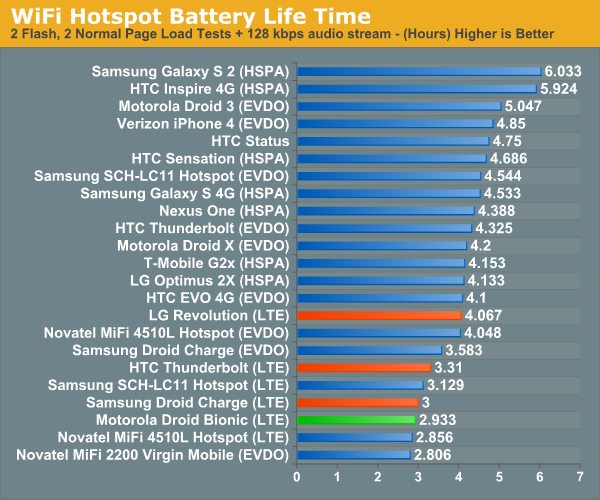
Unfortunately the Bionic doesn't fare very well in either test, despite having the largest capacity battery. There's really no sugar coating those results. I expect 3G/EVDO web browsing and call test time battery life to be slightly better than the Droid 3 at this point owing to the larger battery capacity.
Heat
The other thing about the Bionic is that it gets hot. I've handled a lot of warm smartphones, but the Bionic gets notably warm. After our smartphone battery life test finished, I pulled out my contactless IR thermometer and measured 112 F surface temperature.
It seems to me that the surface of the display gets warm before the backside or rest of the device.
Camera
I've only had a chance to take photos with the rear-facing camera in our lightbox, and have updated some to a gallery alongside a few other photos. In addition I've captured 1080p30 video from the Bionic at our test location. Just like the Droid 3, the Bionic captures 1080p30 video at 15.0 Mbps H.264 high profile.
Note that the lighting conditions this last time were not similar to our other videos, and normally I go to great lengths to ensure similar lighting, however due to the time constraint I didn't get a second day to go back, so these will be re-captured for the final review.
Final Words
Don't think that this replaces any longer-form review, as we're still going to do an in-depth review of the Droid Bionic after we've had more time with it. I just wanted to give some quick impressions on the device and the results of preliminary battery life testing before we get neck-deep in IDF and Microsoft BUILD related coverage.
At this point the Bionic is looking to have similar battery life to the other LTE devices, even with a larger battery and dual core SoC. The rest of the battery life testing suite will really tell the story about whether Motorola's rather mysterious LTE baseband is the culprit here, and we've asked for more information about it and hope to hear back. The Bionic is proving to be incredibly similar to the Droid 3 - they both run the same version of Motoblur, version of Android, same SoC, and possibly even the same (or at least very similar) kernel. Battery life and hot exterior temps aside, however, the Droid Bionic proves that a dual core smartphone with 4G LTE can make web browsing a very speedy experience. Stay tuned for our upcoming full review.


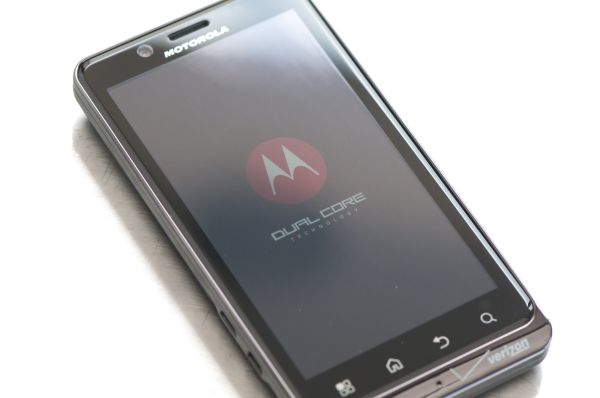
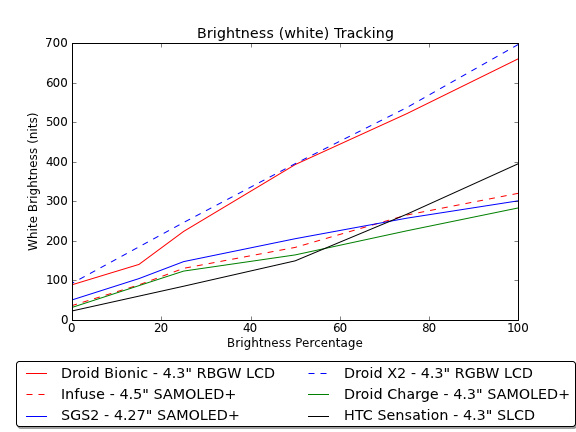
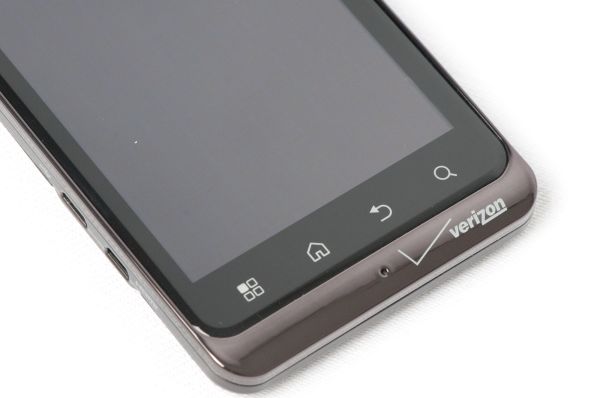
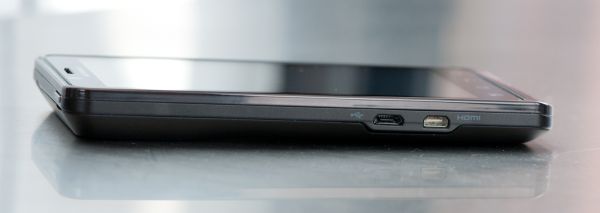
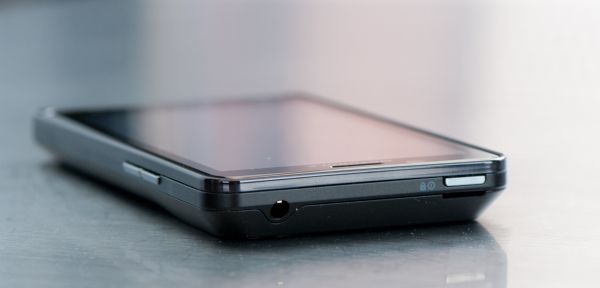
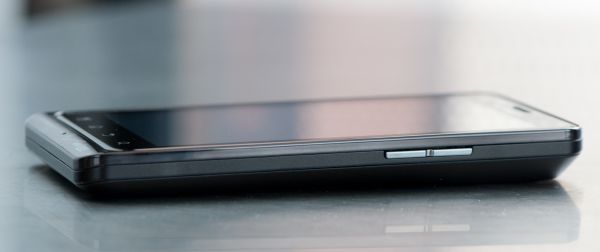






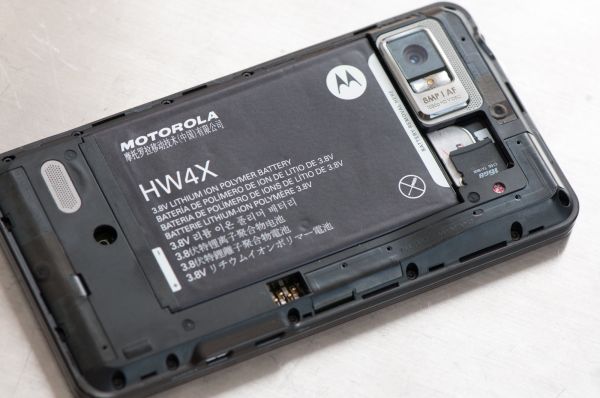
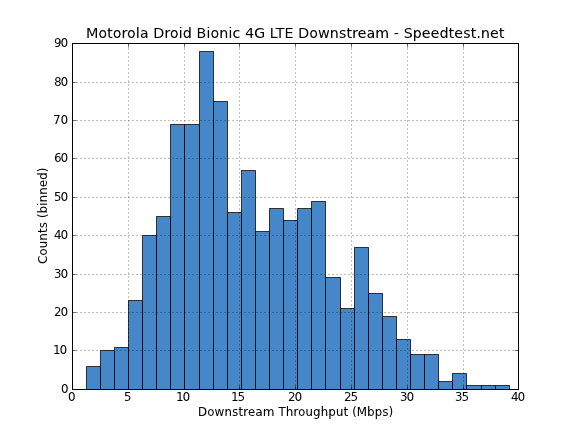
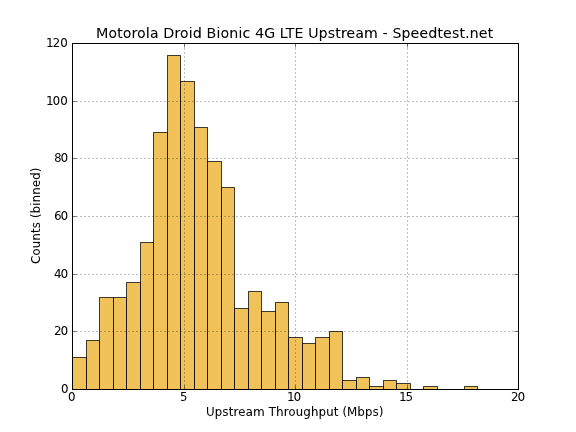








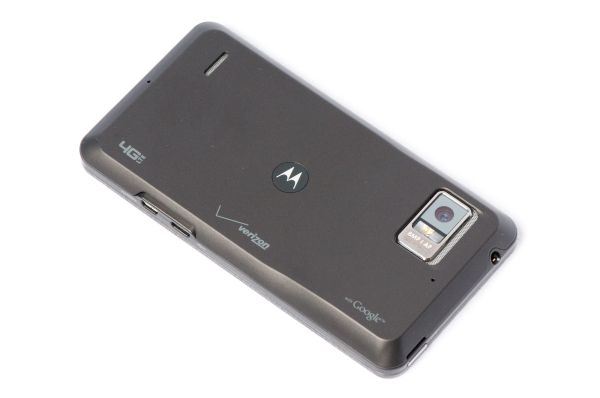








63 Comments
View All Comments
wpwoodjr - Tuesday, September 13, 2011 - link
This phone is so smooth and fluid compared to my DX. It is a tad wider, wish it wasn't.I've been running mostly in 3G mode so have been satisfied with battery life. Around Philly the Verizon 3G is fast enough that I don't really need 4G. I regularly get 1500kbs down.
The GPS is amazing - I have never had to wait more than 10 secs for it to kick in (outside) which is a big deal to me.
The camera is better than the DX, not as much noise reduction so you get more detail.
The pentile screen is fine, you can see a cross-hatch if you have really good eyesight or wear reading glasses, but its not a big deal. The greens are more saturated and better looking than on my DX.
I would like to get AnandTech's (Brian's) take on the number of bits used for color rendering. In the browser, I've noticed some banding on images with subtle background color changes. I think it may be using 16 bits/pixel rather than 24.
I dropped it from my lap in an SUV onto the asphalt and it's fine except for some scratches on the bezel.
It's an all-around fine device, especially if you like Moto / Verizon.
HangFire - Tuesday, September 13, 2011 - link
First of all, what ever happened to the Tbolt 4GB versus 8GB NAND issue?Second, what s/w version of each phone was charted here? I ask because the Tbolt has improved markedly in battery life since the latest update. (I was able to verify that on a warranty replacement when I got to try it before & after again).
Third, while Tbolt battery life is nothing to crow about, I regularly get through an entire workday (including commuting) and come home with 40%, and have on occasion continued through the evening without another charge to end the day just getting into the red. I regularly check eMail and the occasional web page, use Tapatalk and News during lunch etc., not exactly heavy 'net usage but not making an effort to conserve battery power either. I still have checks and syncs set up but for reasonable intervals like hours not every few minutes (except eMail).
As for reliability, it gets down to getting a good one in the first place. Just like out family's two G1's and two G2's and 2 Droid Charge's to get to one good one each. My first Tbolt dynamically changed its own volume and my second had a display issue. Number 3 (still on warranty) has outlasted them both put together and has survived many a bump and drop. Nothing to crow about but when I see my friends and coworkers beaten and battered Motorolas and their catalog of issues I don't see them doing any better than HTC, if anything I don't consider them as sturdy in the long haul. In one respect I lucked out as an early adopter, as I got new replacement Tbolts each time, or maybe factory seconds, as the true refurbs from other consumers didn't have time to cycle through the system when I got mine.
In short the Thunderbolt is far from trash and far from having a useless battery life. After getting through the early life production issues and firmware update for better battery life, it is becoming a workhorse, and everyone wants to play with it, even while they echo the outdated and sometimes misinformed criticism.
Jrouss - Tuesday, September 13, 2011 - link
Though I would argue you should not have to do this to a new phone to make it useful, I ordered the extended battery for 24.99. It is a drastic improvement over the original battery.TrackSmart - Tuesday, September 13, 2011 - link
I agree that the faster processor will get to idle state sooner, but it will still have a greater workload to perform over the course of the battery test.You can test to see if this matters at all. See how many pages-per-hour a slower 3G phone loads during the test. Have a fast LTE phone load pages at a similar rate. If the battery life of the LTE phone is significantly longer in that test compared to the normal Anandtech test (e.g. 15-20% longer), it will be evident.
The current test is still reasonable for comparing phones in the same performance category and on the same network.
wpwoodjr - Wednesday, September 14, 2011 - link
Brian, I hope you will post battery life figures for 3G as well as 4G. It would give a much better picture of how the phone stacks up to other non-4G phones, especially as I don't personally really see the need for 4G speed on my phone so I've been running it in 3G mode.All around, I think Moto have put together a great phone that "does it all" really well. OK so it's not the sexiest phone out there (or almost out there) but it improves on it's predecessors in almost every way. For me, coming from the Droid X, it's a huge difference.
thrasher32 - Thursday, September 15, 2011 - link
I've got the original Droid X and while I like the Bionic, I can't get past that $299 "discount" price, and the accompanying 2 year indentured servitude to Verizon. In addition, I'm still grandfathered into the unlimited data plan, so until my Droid X physically dies, Verizon is outta luck 'cuz I'm gonna stream Netflix all day long without regard to data usage.When my Droid X finally does die, I'm switching to T-Mobile (like the rest of you), I'm tired of being rectally violated by AT&T and Verizon.
coolfx35 - Thursday, September 15, 2011 - link
I just got the Droid Bionic, So I found a notification sound I like and added it to both a new folder called 'notifications' on both the sdcard and sdcard-ext as well as /system/media/audio/notifications.It *still* does not show up in settings > sound> notification ringtone. The file is a valid .ogg file. I post this question on http://www.mydroidbionic.com but no answers so far, so someone here please help. Thanks.
synaesthetic - Thursday, September 15, 2011 - link
This is my issue, personally. While the rush to make beefier and better CPUs and modems for phones seems to be in full swing, nobody seems to be paying attention to making the batteries that power them better.Battery tech has lagged so far behind mobile tech it's not even funny. Seriously, I love my Android phone (a T-Mobile Nexus S) but I have to charge it pretty much daily. This is an issue for me, though I don't know how many other people care as much, but sometimes I find myself *avoiding* using my phone whenever possible just so I can make sure the battery doesn't go out before I can get to a charger.
Dual core, crazy gaming performance, all of that is nice, but honestly I'd rather have my same Nexus S, with it's same "old" HSPA internets, with it's same old single-core CPU... but with a battery that'll last a full day of continuous heavy use.
TrackSmart - Friday, September 16, 2011 - link
I've been saying for years that it would be great to have a very-well-built *phone* that had absurdly long battery life and zero internet features. Carriers don't allow this. Every Verizon phone must support internet and VCAST video, etc. Imagine a phone that was voice-calls only that was about 95% battery inside. It could last practically forever on a charge, be waterproof, and highly impact resistant.That being said, once you start talking about smartphones, you are really talking about personal computing devices. And the usual race for the best specifications applies. The smartphone you described would have a dedicated niche market, but wouldn't be the huge 'hit' device that the phone makers are looking for...
HTC or Samsung could make such a phone if they wanted. And Apple, well, they do prioritize battery life more than most carriers. On the Android side, Motorola is usually tops when it comes to voice-call battery life...
lefenzy - Monday, September 19, 2011 - link
Why is it that Anandtech graphs exclude HTC's Droid Incredible 2, a recent phone that offers decent performance in a portable 4inch screen package? As a recent 3G phone comparable to the Droid 3, it is worth including in the graphs. It certainly offers better battery life than the latest LTE and dual core phones.